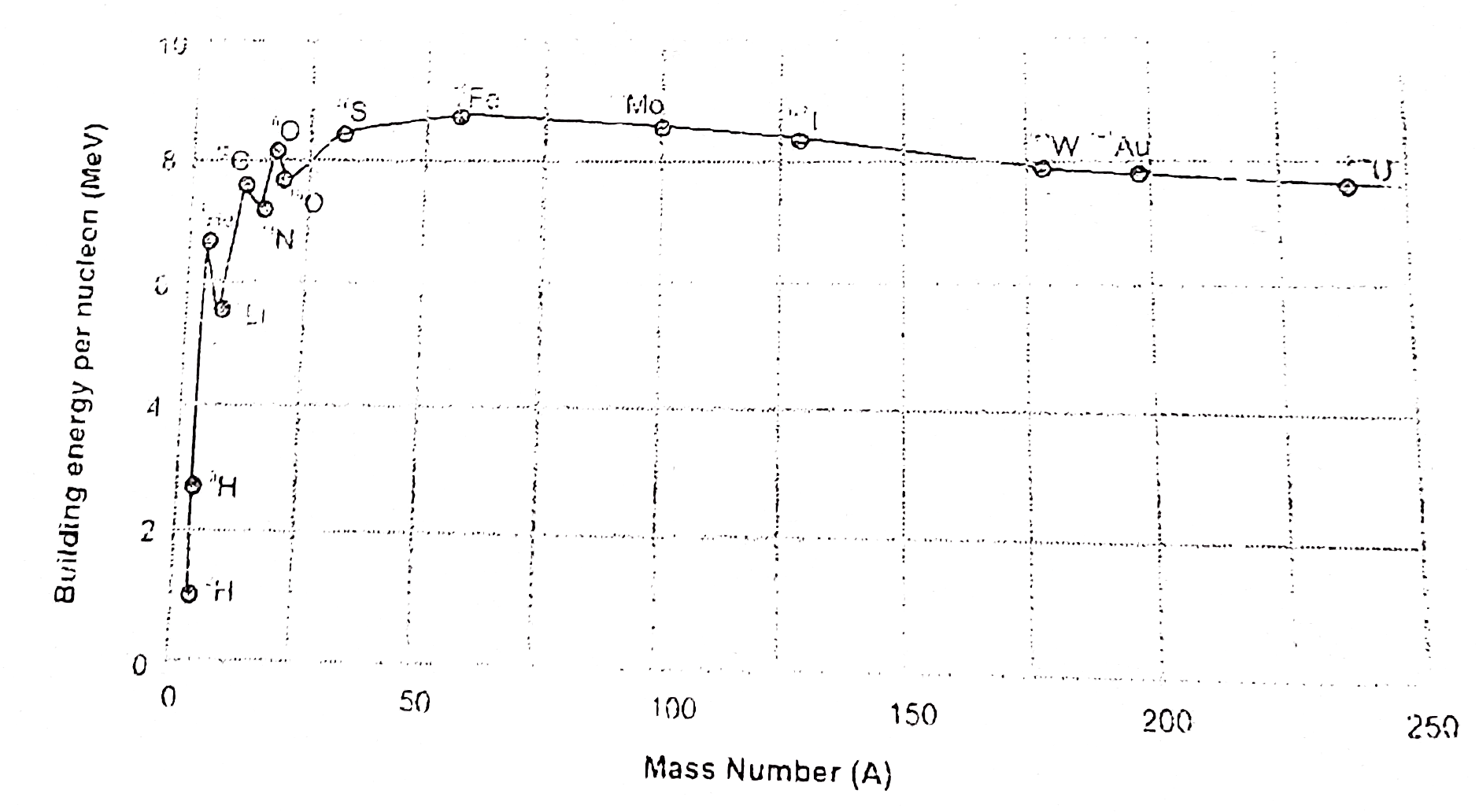As the mass number A increases, the binding energy per nucleon in a nucleus.
increases
decreases
remains the same
varies in a way that depends on the actual value of A
The correct Answer is:D
To solve the question regarding how the binding energy per nucleon (EBN) changes as the mass number (A) increases, we can follow these steps:
1. Understanding Binding Energy per Nucleon (EBN):
- The binding energy per nucleon is defined as the total binding energy of the nucleus divided by the number of nucleons (protons and neutrons) in the nucleus. It indicates how tightly the nucleons are bound together.
2. Analyzing the Relationship with Mass Number (A):
- The mass number (A) is the total number of protons and neutrons in a nucleus. As A increases, we need to observe how EBN behaves.
3. Plotting EBN vs. A:
- A graph of binding energy per nucleon (EBN) versus mass number (A) typically shows a curve. Initially, as A increases from low values, EBN increases. This indicates that nuclei become more stable with increasing mass number.
4. Identifying the Peak:
- The curve reaches a maximum around A = 56, which corresponds to iron (Fe). At this point, the binding energy per nucleon is at its highest.
5. Behavior Beyond the Peak:
- After reaching the peak at A = 56, as A continues to increase (for heavier nuclei), the binding energy per nucleon starts to decrease. This indicates that heavier nuclei are less stable compared to those around iron.
6. Conclusion:
- Therefore, the behavior of binding energy per nucleon as mass number A increases is not uniform. It increases up to a certain point (around A = 56) and then starts to decrease for heavier nuclei. Thus, the binding energy per nucleon varies depending on the value of A.
Final Answer:
The binding energy per nucleon in a nucleus varies in a way that depends on the actual value of A.
- The binding energy per nucleon is defined as the total binding energy of the nucleus divided by the number of nucleons (protons and neutrons) in the nucleus. It indicates how tightly the nucleons are bound together.
- The mass number (A) is the total number of protons and neutrons in a nucleus. As A increases, we need to observe how EBN behaves.
- A graph of binding energy per nucleon (EBN) versus mass number (A) typically shows a curve. Initially, as A increases from low values, EBN increases. This indicates that nuclei become more stable with increasing mass number.
- The curve reaches a maximum around A = 56, which corresponds to iron (Fe). At this point, the binding energy per nucleon is at its highest.
- After reaching the peak at A = 56, as A continues to increase (for heavier nuclei), the binding energy per nucleon starts to decrease. This indicates that heavier nuclei are less stable compared to those around iron.
- Therefore, the behavior of binding energy per nucleon as mass number A increases is not uniform. It increases up to a certain point (around A = 56) and then starts to decrease for heavier nuclei. Thus, the binding energy per nucleon varies depending on the value of A.
The binding energy per nucleon in a nucleus varies in a way that depends on the actual value of A.
Topper's Solved these Questions
- THE NUCLEOUSBOOK - HC VERMA ENGLISHCHAPTER - THE NUCLEOUSEXERCISE - Objective 2
10 Videos
- THE NUCLEOUSBOOK - HC VERMA ENGLISHCHAPTER - THE NUCLEOUSEXERCISE - Exercise
53 Videos
- THE NUCLEOUSBOOK - HC VERMA ENGLISHCHAPTER - THE NUCLEOUSEXERCISE - Work out Example
15 Videos
- SPEED OF LIGHTBOOK - HC VERMA ENGLISHCHAPTER - SPEED OF LIGHTEXERCISE - Question for short Answer
5 Videos
- THE SPECIAL THEORY OF RELATIVITYBOOK - HC VERMA ENGLISHCHAPTER - THE SPECIAL THEORY OF RELATIVITYEXERCISE - Short answer
2 Videos
Similar Questions
Consider the following statements and state whether true (T ) or false ( F ) :
(i) Nuclear fission is normally followed by emission of β− - particles.
(ii)Emission of α− particle is normally followed by emission of γ− rays
(iii) As the mass number A increases, the binding energy per nucleon in a nucleus also increases
Choose the correct order from the options given below
View SolutionAssertion: The nuclear energy can be obtained by the nuclear fission of heavier nuclei as well as by fusion of lighter nuclei.
Reason: As the mass number increases, the binding energy per nucleon, first increases and then decreases.
View SolutionThe value of binding energy per nucleon is
View SolutionThe binding energy per nucleon is maximum in the case of.
View SolutionThe binding energy per nucleon is maximum in the case of.
View SolutionBinding energy of a nucleus is.
View SolutionThe binding energy of nucleus is a measure of its.
View SolutionWhen the number of nucleons in a nuclues increases the binding energy per nucleon
View SolutionAverage binding energy per nucleon over a wide range is
View SolutionDraw the graph showing thervariation of binding energy per nucleon with mass number. Give therason for the decrease of binding energy per nucleon for nuclei with high mass numbers.

The binding energy per nucleon for nuclei with high mass number is low due to the large coulomb repulsion between the protons inside these nuclei.
View Solution